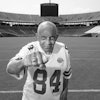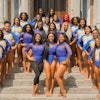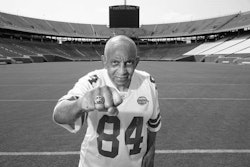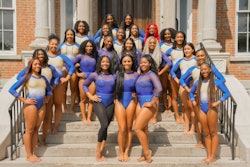A Driving Force in Nascar
Bill Lester, who gave up his career in corporate America to follow his passion, hopes his participation will attract a wider and more diverse fan base to auto racing.
By Frank J. Matthews
Minority participation and interest in sports is legendary — depending on what sport you are talking about. Blacks have long been a major factor in the popularity of basketball and football. Tiger Woods’ success has contributed to an explosion of interest in golf within the Black community. Arthur Ashe brought tennis into the Black consciousness, and the exploits of Venus and Serena Williams have only increased interest in that sport. But some sports, like auto racing, have yet to be embraced by large numbers of minorities. Can you name any of the drivers in NASCAR’s three levels — the Nextel Cup, Busch Grand National and the Craftsman Truck Series? Even die-hard NASCAR fans might have a hard time naming the one Black driver currently earning a living on the circuit. His name is Bill Lester, and he recently spoke to Diverse about his journey.
DI: You’re currently on the NASCAR circuit, but our readers would be interested to know that you have an electrical engineering degree from the University of California, Berkeley. How was your Berkeley experience?
BL: It was great. It was extremely competitive. I don’t recall any other African-Americans getting their degree in electrical engineering/ computer science when I was there [in 1984]. I didn’t set the bar, but I got out of there. And with a Berkeley degree, I could pretty much write my own ticket. So I joined Hewlett-Packard, where I had interned
for three straight summers, as a research and development
project manager.
DI: How long did you stay with HP?
BL: Sixteen years, when you factor in the three summer internships.
DI: Were you a recreational driver during those years?
BL: I did amateur racing from graduation in 1984 all the way until ’88. And then in 1989, I made my professional racing debut at
Sonoma in the International Motor Sports Association driving a Chevrolet Camaro.
DI: How often did you race after that first professional race?
BL: Not very often, because it’s extremely expensive. Most of the guys I was racing against were funded by corporations and were racing full time. I was essentially just racing as much as I could with whatever resources I could gain. So I did a couple more professional races in 1990 and then I didn’t race again until ’96. I just focused on my professional career at Hewlett-Packard. I was very successful there, but my real love and passion was racing.
DI: What was it like to get back into racing after being away from it for a few years?
BL: My first race back was at Road America in Wisconsin in the Sports Car Club of America World Challenge. After five years
I didn’t really know if I was still good at it or whether I still had a passion for it. But in my first race back behind the wheel I finished fourth, and in my second race I finished third, and this was against professionals who were racing full time. So with that success and me realizing that I still loved it, I decided that this is what I really want to do. In ’98, with my wife’s blessing, I took a six-month leave of absence from Hewlett-Packard while I was trying to gain traction with my racing activities. From 1998 to 2001 I wasn’t making any real money.
DI: Did you have to finance your own racing pursuits?
BL: No, I was taking advantage of opportunities that were being presented to me. I was doing a lot of what’s called “one of rides,” which are opportunities to do a race here and do a race there, that sort of thing.
DI: Was it a difficult decision for you to essentially give up your career to pursue racing?
BL: No it wasn’t, because I was pursuing what it is I wanted to do with my life. It was hard from everybody else’s perspective because they couldn’t understand why somebody who was so successful would risk all that to do something that they weren’t sure they were going to be able to achieve. But it wasn’t a risk for me because I define success as happiness, and I wasn’t happy doing what I was doing in corporate America. My real love and passion was racing, and I knew with my foundation that I could always get back into that discipline if had to, but I didn’t want to.
DI: Last year you were the first African-American to qualify for a Nextel Cup race in two decades. The last one to do it was Willy T. Ribbs in 1986. Did you two ever get together and compare notes?
BL: When I was working in the high-tech environment in Silicon Valley, that’s almost right next door to where he lives. So I met him when I first started doing amateur racing in the mid-1980s. We became friends. We supported each other throughout our careers. He retired from racing in 2001.
DI: What’s your experience with NASCAR been like so far?
BL: I’ve enjoyed it. I’ve enjoyed being part of the fastest growing spectator sport in this country. Needless to say, I am the face of diversity. I happen to be the only African-American racing in the sport. There are others that have been in a race or two, but I’m the only one who is racing full time.
DI: What kind of response have you gotten from the fans and the other teams?
BL: It’s been positive. I’m respected in the garage. I’m respected amongst my fellow drivers. And the fan base has welcomed me as well, so it’s very satisfying and relieving because traditionally NASCAR hasn’t been very welcoming to anybody outside the Southeast who doesn’t happen to be a White male. It’s surprising too, because I never anticipated getting the reception and support that I’ve gotten.
DI: Do you think your experience has been easier than what
Willy Ribbs endured in the ’80s?
BL: I think so, yes. I didn’t walk in his shoes. But he is one of the guys who helped pave the way for me, just like Wendell Scott helped pave the way for Willy. I hope to think that I’ll pave the way for the next African-American driver.
DI: NASCAR has a program called Drive for Diversity,
which Chris Bristol is participating in. Can he be NASCAR’s next Black driver?
BL: It remains to be seen. It’s all a matter of whether he has the right opportunities presented to him and whether he is able to take advantage of them when they are presented. There are a number of guys on the horizon that, if given the right opportunities, could
do well.
DI: Do you think NASCAR is hoping that you can do for auto racing what Tiger Woods and the Williams sisters did for golf and tennis?
BL: There’s no question that NASCAR wants to make the sport more inclusive. That’s one of their objectives, to make the sport more reflective of the hue of this country. So programs like Drive for Diversity are steps in that direction. So there’s no doubt that they would like to see the sport resonate more with people of color. They are very interested and supportive of what I’m doing.
–Frank J. Matthews
There are currently 0 comments on this story.
Click here to post a comment.
© Copyright 2005 by DiverseEducation.com



















